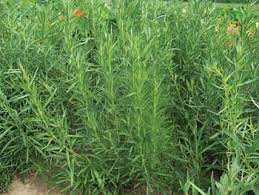Last Updated on August 16, 2023 by Real Men Sow
Russian tarragon is not a common herb to grow at home. However, it is worth the effort, especially if your preference is French cuisine. It’s used to enhance the flavour of chicken and fish dishes.
Tarragon is a perennial. One plant will produce many leaves over the years.
However, the Russian tarragon’s winter toughness and general resilience are its true strengths. Andrew says that Russian tarragon is great for people who live in colder climates. It can withstand temperatures as low as -4°F (-20°C), so it is ideal for northerners.
Sowing Russian Tarragon
In small pots with good seed compost, sow Russian tarragon plants from April to May. Cover the seeds with a lid. Place the seeds in a propagator at 15-20 °C (60–70 °F).
Once the seedlings have grown sufficiently large to be able to handle them, you can transplant them into individual pots. After they reach about 10 degrees Celsius (50 degrees Fahrenheit), after hardening, you can move them outside to outdoor conditions for 7-10 days. Place the seedlings at a 45cm (18in) distance apart.
Planting Russian Tarragon
To improve drainage, you should dig into the soil and add lots of organic matter such as compost. Place the root ball in the hole. Add more organic matter to the soil, and then fill the hole. Water in and sprinkle granular general feed on top.
General Care Guide for Russian Tarragon
Russian Tarragon requires very little care. It can be grown with just a little water once established.
Soil
The plants in the ground will not require much water, if any, in summer. However, watering may be necessary for very light soils that drain quickly during dry periods. Give your plants one to two light feeds of liquid plant food in the summer. It requires well-drained soil. The roots won’t tolerate being waterlogged, even for a brief time.
Water
It is a drought-tolerant plant once established and doesn’t require much water. It is best to add water if you are growing the plant for harvesting purposes and not decorative. Plants that are not watered tend to be less aromatic and shorter.
It is best to place a soaker hose around the base of your plant. Cover it with mulch, such as wood chips. You can water for between 15-30 minutes each day, depending on how much water you have. Mulch keeps water near the ground, so it doesn’t evaporate. This allows for less water consumption. You can also use plastic mulch sheeting to keep weeds down and allow the soil to remain moist. However, it may be a little unsightly in small herb gardens.
Pests
The oils and scent of Russian Tarragon repel insects, making it an excellent choice for outdoor gathering places such as patios or other outdoor spaces.
Winter
Russian tarragon, a tough and durable plant, becomes a hardy rootstock in winter. It likes to live in poor soil, and it produces its best flavour. It will lose its fragrance if it is given too much organic matter. To protect against winter, cut the stems and mulch the root crowns in the colder zones. This is not required if you are using black plastic mulch.
Harvesting
You can harvest leaves anytime between May and September/October. To do this, you will need to use scissors or secateurs to trim the stems. Younger leaves are more flavorful than older ones.
You can freeze or dry the leaves for winter use. If you have leaves that were picked in the middle of summer, freezing is the best choice.
To make Russian tarragon vinegar, you can also take young sprigs from the garden and mix them with white wine vinegar.


